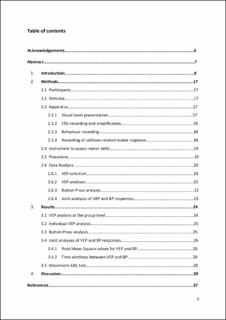| dc.description.abstract | Through high-density electroencephalogram (EEG), the present study investigated brain responses and timing of prospective responses to a looming stimulus in preterm and full-term children at 6 years of age. A visual paradigm of a looming stimulus approaching at three different speeds was used, along with a response pad to estimate the time-to-collision with the loom. Additionally, motor performance was assessed through the Movement-ABC test. Looming-related visual evoked potentials (VEPs), button press (BPs) responses, and motor performance in the M-ABC test were further analyzed at the individual and group levels. Analyses performed on the VEPs showed that both groups displayed their brain responses at fixed times across speeds, indicating the use of an efficient strategy based on time to estimate the time-to-collision with the loom. However, full-terms displayed their VEPs significantly closer to time-to-collision than preterms, which is associated with a more efficient transmission of visual motion information. Two preterm children stood out in the individual VEP analysis, suggesting that these participants were using a less efficient strategy to estimate the time-to-collision with the loom. Analyses on BPs showed that both groups displayed larger deviations from time-to-collision with decreasing speed of the loom, which could suggest the use of a less efficient timing strategy in the motor domain to estimate the time-to-collision. No significant differences in BPs between groups were found. Further analyses performed on VEPs and BPs indicated that the preterm group showed significant differences in the deviation between their visual and motor responses, while full-terms showed similar deviation values between their two types of response. The similar deviation values amongst full-terms could be an indicator of a steadier visuo-motor development. Moreover, analyses of time windows between VEPs and BPs showed that the preterm group displayed larger time windows than full-terms, which could be associated with longer processing times required to prepare and emit a prospective response amongst the preterm participants. Finally, one participant from each group stood out in the M-ABC test with scores that indicated impairments in the motor domain. However, no significant differences were observed between groups in this test. Overall, results from the BP analyses and the M-ABC test suggest a similar performance in motor skills amongst all children, which could be explained by experience with self-locomotion and synaptic plasticity as a result of experience with the environment. Yet, the VEP and time window analyses point to significant differences in the transmission and processing of motion information between groups. Inefficient transmission of visual motion information along with longer processing times amongst preterms could be due to a dorsal stream vulnerability as a result of being born too soon. Considering these results, follow-up studies are required to determine if preterms keep presenting these response patterns at later stages in life, or if they manage to develop a response pattern similar to that of the full-term group, which could indicate that they have successfully caught-up with them. | |
